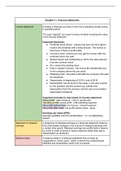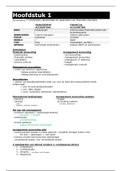Income statement provides a financial summary of the firm's operating results during
a specified period
*if it says *deposit* you need to minus it before including the value
in the income statement
Important keywords:
Preferred stock (fixed) : owners that have the first right to
receive the dividends with a fixed amount. The money is
fixed even if there is profit made.
Common stock: owners can only get the money after the
preferred stock has paid
Shared issues and outstanding in 2019: the value derived
from the common stock
Par: means the starting value
Paid in capital in excess : the money the shareholder pay
to the company above the par value
Retained profit : the profit is left after the company has paid
the dividends
Depreciation in beginning of 2019 = end of 2018
Depreciation can be found in two ways = one way is given
by the question and the second you subtract the
depreciation from the previous and the new accumulated
depreciation dividends
Important formulas to note based on income statement:
Gross profit : sales revenue - cost of goods sold
Operating profits: gross profit - total operating expense
Net profits before taxes: net income - interest expense
Net profits after taxes: net profits before taxes - taxes
Earnings per share (EPS) :
earrings available common stockholders / no. of outstanding
shares
Statement of retained A statement of retained earnings is a financial statement made by
earrings firms that details changes in the volume of retained earnings over
a certain time period. Retained earnings are profits held in reserve
by a firm in order to invest in future initiatives rather than pay to
shareholders as dividends.
Balance sheet A balance sheet is a financial statement that conveys an
organization's "book value," which is derived by subtracting all
liabilities and shareholder equity from all assets.
, Cash flow Cash Flow (CF) is the rise or reduction in the quantity of money
owned by a company, organization, or individual. The phrase is
used in finance to indicate the quantity of cash (money) created or
consumed in a certain time period.
Chapter 3 | Financial ratios
Definition ratio analysis involves methods of calculating and interpreting financial ratios to
analy e and monitor the firm s performance
Interested parties Investors, creditors (people who you owe) & the management
Types of ratio Cross sectional: comparison of different firms at the same point
comparisons time
Time series: evaluate performance of a single firm overtime
Types of ratio analysis Liquidity ratio: indicators a firm's ability to satisfy its short term
obligations as they come due
Activity ratio: indicators for the speed of converting assets &
liabilities into sales or cash
Debt ratios: indicators for the extent in which companies are
financed with debts instead of equity
Profitability ratios: indicators for the ability to generate profit in
relation to sales,assets, or owners investment
Market ratios: indicators for how a firm s market value relates to
certain accounting values
Liquidity ratio 1. Current ratio = current assets / current liabilities
(2)
2. Quick ratio = (current assets - inventories) / current
liabilities
Activity ratio 1. Inventory turnover = cost of goods sold / inventory
(4)
2. Average collection period = (365 * account receivable) /
annual SALES
How long is my customers paying their debts to me
3. Average payment period = (365 * accounts payable) /
annual PURCHASE
How long does it take the company to pay out
suppliers



